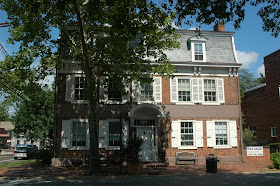That headline isn't a typo. Yes, we found ourselves journeying to the EARTH Center. Who'd think it would be in North Brunswick?
Okay, okay... I'm playing around a little bit, but when Ivan and I saw a small brown sign pointing us to the EARTH Center off Route 130, we had to check it out. Neither of us had heard of it before, and, well, it was a brown sign, which designates a park. We'd had a largely unsuccessful morning of birding, so maybe scouting a new location would perk us up a bit.
 |
| Access to Davidson's Mill Pond |
The Brunswicks can offer some interesting surprises. While easy access to the Turnpike and Routes 1, 18 and 130 has fostered a great deal of development, pockets of bucolic scenery and farmland are still scattered about the remaining open space. Our trip to EARTH brought us past a few houses on winding Riva Avenue, but we soon found ourselves at the scenic Davidson's Mill Pond Park.
The park itself has a couple of lovely ponds and the stone remnants of the foundation of its eponymous mill. It's a nice place to walk your dog, have a picnic or just sit and meditate on a nice day. We, however, were more driven to find out what all of this EARTH stuff is about. The answer, as we saw from a directional sign, was past a wooden gate and down a paved drive, so we parked by the Mill Pond boat launch and started our stroll.
 |
| Almost to the EARTH Center! |
EARTH, as it turns out, is an acronym for
Environment
Agriculture
Research
Teaching
Health, and the center is part of the Rutgers Cooperative Extension. As you might now, each county has an Extension of the larger New Jersey Agricultural Experiment Station. Basically, it's the public outreach arm that Rutgers operates to fulfill its obligation as the state's land grant university. Each Extension offers an array of classes and educational services on topics like gardening, home economics, nutrition, horticulture and the like. They're a good resource if you can't figure out why your tomato plants aren't producing, if you find an invasive species in your yard that defies identification, or if you're looking for an environmentally sound solution for a stink bug infestation in your house.
 |
These tall grasses looked like a great buffet
for seed-eating birds! |
We seemed to be the only birders at EARTH. While we were getting a lay of the land, a few people came by, walking their dogs or checking out the short trails meandering through the woods, but no one had binoculars. We were also the only people who showed any curiosity about the solar installation, cultivated rain and butterfly gardens, and the small building that looked like a kids' clubhouse.
Ivan was on the lookout for sparrows, so he was drawn, magnet-like, to the large acreage of grasses beyond. About five feet high and gone to seed, the grasses were sectioned off with flexible fencing and labeled in a way that seemed to denote the nutrients they'd been given. Some got commercial fertilizer, while others got compost or manure, or nothing at all. It looked like a good experiment to teach kids about cultivation techniques.
We weren't seeing many birds, but then it was midday and they were probably laying low for the next several hours. Just as we were reluctantly agreeing that our time there was only a reconnaissance mission for future visits, sparrows started to emerge. One would pop up, fly 30 feet or so and duck back down into the growth. Occasionally one would perch on the fencing for a minute or two before going back into hiding, but for the most part, we had to try to identify them on the wing.
 |
| Another view of EARTH |
We had more luck near an open-air structure several feet away. A host of savannah sparrows and phoebes bopped around in the open, allowing us to get a good look for a few minutes before they went back into hiding or flew away.
Noting a stand of pine trees in the distance, Ivan went to check for signs of owls while I found a bench and quietly took in the surroundings. How is it that we'd never heard of this place? It looks to be great habitat for grassland birds, and raptors should also be around, drawn by seed-eating rodents. Some other birder had to have found it before us, yet it hasn't shown up on any lists or bulletin boards.
Was it our own little discovery? Right now, it seems to be. Regardless, we'll be returning to EARTH sometime soon. It's inevitable.
















